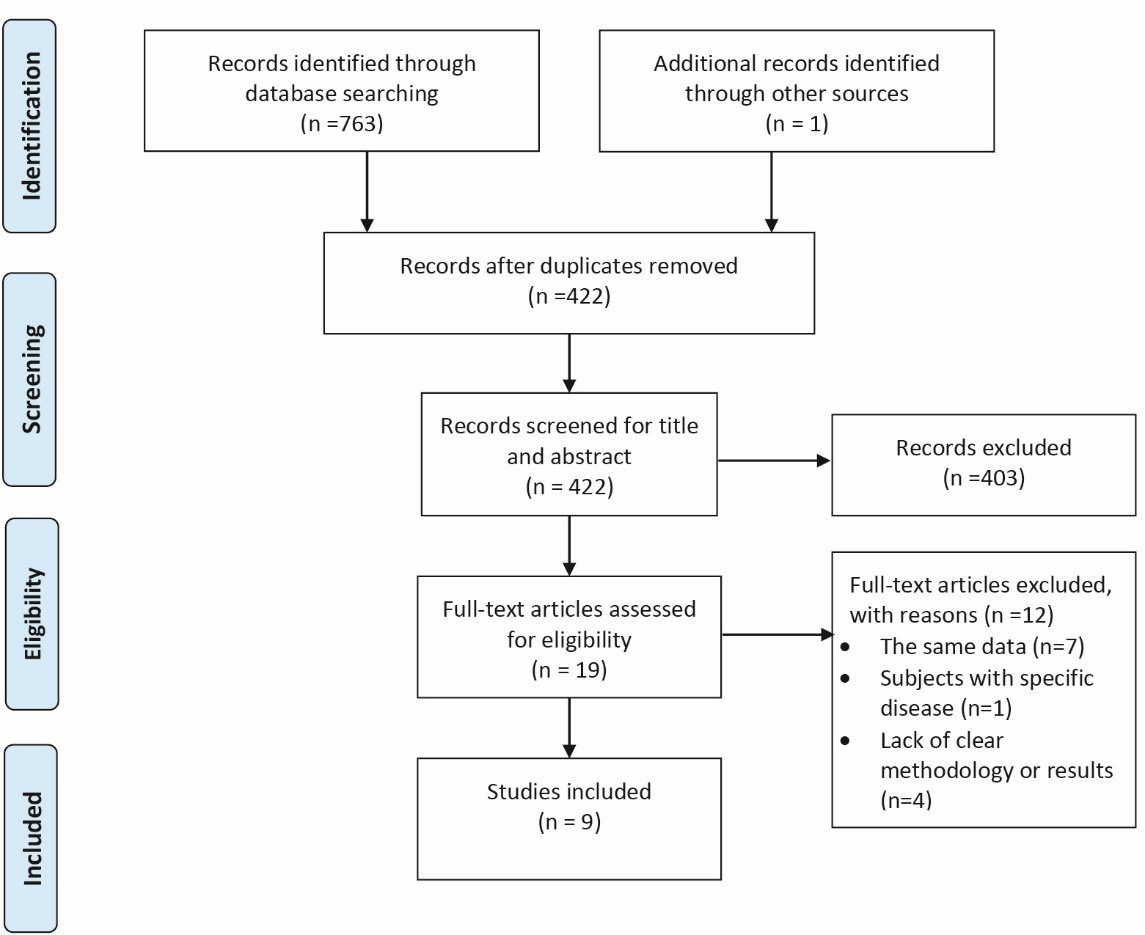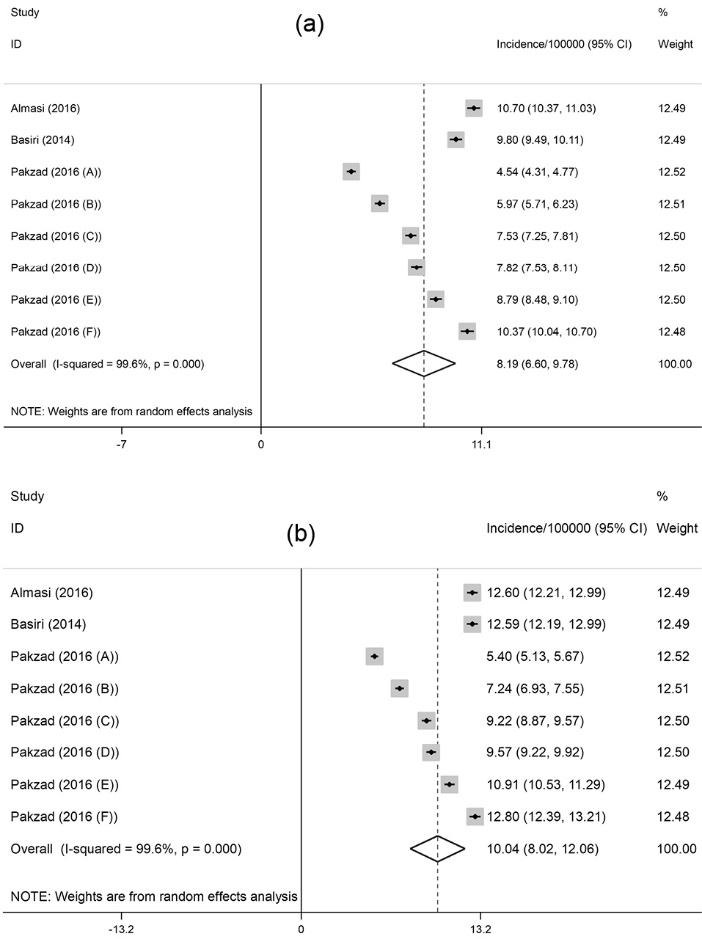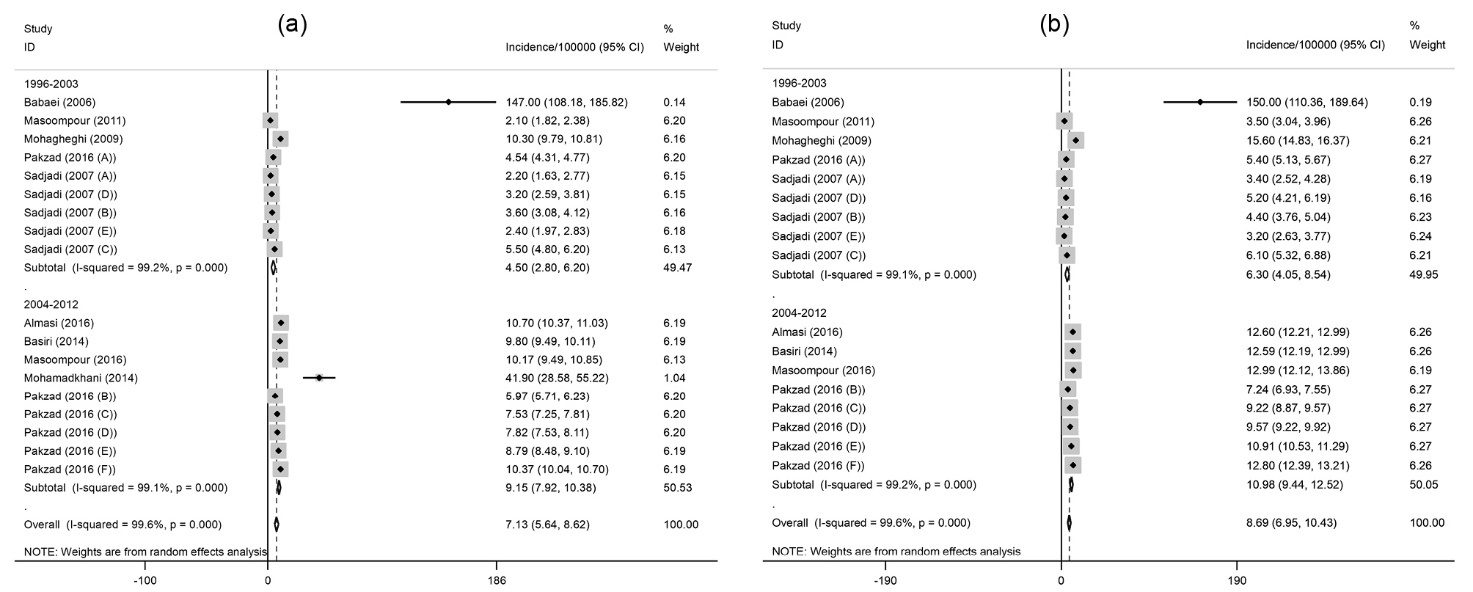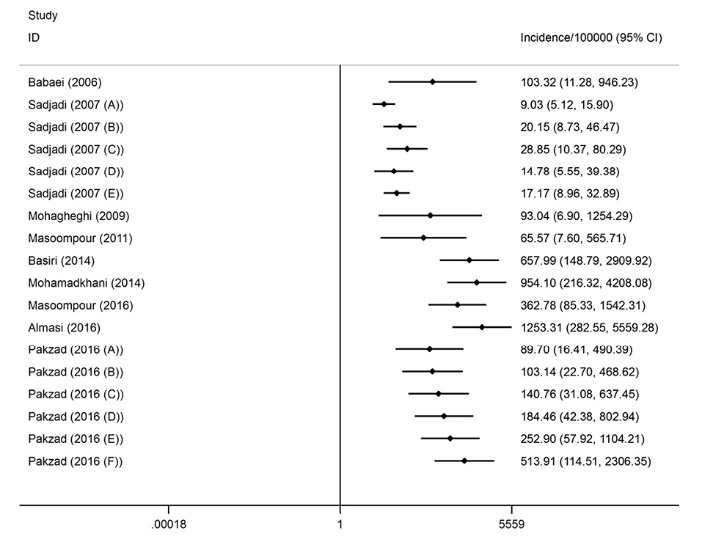A systematic review and meta-analysis on incidence of prostate cancer in Iran
Health Promotion Perspectives, 9(2), 92-98; DOI:10.15171/hpp.2019.13
Systematic Review
A systematic review and meta-analysis on incidence of prostate cancer in Iran
Asaad Moradi1, Mohammad Zamani2,3, Emadoddin Moudi4,5 ,*
1
Department of Urology, Firozgar Hospital, Iran University of Medical Sciences, Tehran, Iran
2
Student Research Committee, School of Medicine, Babol University of Medical Sciences, Babol, Iran
3
Cancer Research Center, Health Research Institute, Babol University of Medical Sciences, Babol, Iran
4
Clinical Research Development Center, Shahid Beheshti Hospital, Babol University of Medical Sciences, Babol, Iran
5
Department of Urology, Babol University of Medical Sciences, Babol, Iran
Email: emadmoudi@gmail.com
© 2019 The Author(s). This is an open access article distributed under the terms of the Creative Commons Attribution License (http://creativecommons.org/licenses/by/4.0/), which permits unrestricted use, distribution, and reproduction in any medium, provided the original work is properly cited.
Abstract
Background: Prostate cancer is a global health concern. In Iran, its epidemiology is not precisely recognized. We aimed to evaluate incidence of prostate cancer among Iranian populations.
Methods: In this systematic review, we searched the databases PubMed, Web of Sciences, Scopus and Google Scholar for English studies and the databases Magiran, Scientific information Database, IranMedex and IranDoc for Persian studies, using related keywords. The cross sectional articles published from inception to 31 December 2018 were included. Meta-analysis was conducted on the collected data with STATA software using random effects model.
Results: Out of 763 articles initially obtained, 9 articles were finally included after applying the predefined exclusion criteria. Analysis of 9 studies on the incidence of prostate cancer showed a crude rate of 7.1 per 100000 population (95% confidence interval [CI]: 5.6-8.6). Also, the pooled age-standardized incidence rate was 8.7 per 100000 (95% CI: 6.7-10.4). Studies performed in the period 2004-2012 had significantly a higher pooled estimate of the crude incidence rate (9.2 per 100000 [95% CI: 7.9-10.4]) compared with those conducted in the period 1996-2003 (4.5 per 100000 [95% CI: 2.8-6.2]). This trend was also observed based on the age-standardized incidence rate (11 per 100000 [95% CI: 9.4-12.5] versus 6.3 per 100000[95% CI: 4-8.5]).
Conclusion: Despite low rate of prostate cancer occurrence in Iran, it is recommended that preventive measures be taken against this disease by health policymakers. Also, more epidemiological studies are needed to better find out the pattern of prostate cancer among Iranian populations.
Keywords: Prostate neoplasms, Incidence, Epidemiology, Systematic review, Meta-analysis
Citation: Moradi A, Zamani M, Moudi E. A systematic review and meta-analysis on incidence of prostate cancer in Iran. Health PromotPerspect. 2019;9(2):92-98. doi: 10.15171/hpp.2019.13.
Background
Prostate cancer is presently one of the major health concerns in the world.1 It is globally the second most frequent malignancy and the fifth leading cause of cancer deaths for males.2,3 Its epidemiology varies between different regions, that is, western countries has lower rates than eastern countries.4
According to the Global Burden of Disease study, 1.4 million new cases of prostate cancer was recorded in 2016 and it was determined as the most common incident cancer in males. Also, 381 000 deaths were attributed to this disease.5 It is expected that new cases of prostate cancer and the death number will reach to 1.7 million and 499 000 people around the world by 2030, respectively.6
Iran, a developing country, is experiencing an epidemiological transition. The burden of cancer has been associated with an ascending trend in this country over the past decades.7,8 According to the report by Ministry of Health in Iran, cancer is the third cause of death and prostate cancer is one of the ten most frequent cancers.9 A previous study in 2005 revealed that it is the second most prevalent cancer among genitourinary cancers in Iranian males.10 So, strategic planning is needed to better control this disease in Iran. To accomplish this aim, determining epidemiological patterns of the cancer is necessary. Cancer registries established across Iran have been a positive step in this regard. However, no inclusive and precise report is available on the epidemiology of prostate cancer in this country. For this reason, we systematically reviewed the literature on the incidence of prostate cancer in Iran and attempted to provide comprehensive information about this subject. These data would be helpful to health policy-makers and physicians for better planning and prevention and also making decisions on management and treatment of the patients with prostate cancer.
Materials and Methods
Information sources and search strategy
The authors undertook a literature search of the following databases from inception to 31 December 2018: PubMed, Web of Sciences, Scopus and Google Scholar. The related terms were searched in the Medical Subject Headings (MeSH) database, and finally, the keywords “prostatic neoplasm” OR “prostatic neoplasms” OR “prostate cancer” OR “prostate cancers” OR “cancer of prostate” OR “cancer of the prostate” AND “epidemiology” OR “prevalence” OR “incidence” OR “frequency” AND “Iran” OR “Iranian” were selected. The search was limited to Title/Abstract. It was also limited to the affiliation “Iran”. The Persian equivalents of the keywords were used for searching the national Persian databases, including Magiran and Scientific Information Database (SID), IranMedex and IranDoc. We also manually searched the reference lists of each included article for additional sources.
The present systematic review and meta-analysis was conducted according to the PRISMA (Preferred reporting items for systematic review and meta-analysis) guideline.11 The protocol of this systematic review and meta-analysis has been registered in the PROSPERO registry (CRD42018102421).
Inclusion and exclusion criteria
We included all English and Persian cross-sectional studies that reported the incidence of prostate cancer among Iranian population. The exclusion criteria for our study were the following: Reviews, case reports, correspondences and editorials, Duplicate articles or studies reporting on the same population, Case-control studies, Studies included subjects with other specific conditions (e.g., cancer of other organs, renal transplantation), and Articles without explicit methodology or results.
Study selection and data extraction
Two authors (MZ and EM) independently assessed the study eligibility by reviewing the titles and abstracts of all potential citations. Discrepancies were resolved by consensus between the reviewers. Full-text of the relevant articles was assessed. The following data were extracted from each included study: first author’s name, location of study, study period, population size, diagnostic method, and crude rate and/or age-standardized rate (ASR) of the incidence. If multiple publications of the same population were retrieved, the one giving more detail was chosen.
Statistical analysis
The meta-analysis was conducted using the statistical software STATA V13 (StataCorp, College Station, TX, USA). Point estimates and their 95% confidence intervals (CIs) were calculated. When a study reported the incidence rate in different times, we included them as a separate report in the analysis, if applicable. We performed a subgroup analysis according to the region for incidence of prostate cancer. Also, a sub-analysis was conducted to evaluate the incidence stratified by time. In this regard, we split the study period into 1996-2004 and 2005-2012. Heterogeneity was checked using the I2 index. We used random effects model to combine the effect estimates from studies. The cumulative meta-analysis was conducted based on year of publication. Publication bias was assessed using a funnel plot, Begg’s and Egger’s tests.
Results
The search yielded a total 763 articles: 562 from the English databases and 201 from the Persian databases. After assessing title and abstract, 403 studies were excluded due to meeting the predefined exclusion criteria. Then, full-text of the remaining 19 articles was retrieved for more detailed evaluation. The manual search found 1 additional article. Finally, 9 papers were included in the study. Figure 1 shows the results of search strategy according to the PRISMA (Preferred reporting items for systematic review and meta-analysis) flow diagram.11

Figure 1. Flow diagram of study selection.
Incidence of Prostate Cancer
A total of 9 articles on the incidence were finally included (Table 1). Three studies reported the incidence rate of prostate cancer in national populations and others were restricted to the local cancer registries, including Ardabil, Fars, Golestan, Guilan, Kerman, Mazandaran, Semnan and Tehran. The studies period ranged from 1996 to 2012. All of the methods used for diagnosis of prostate cancer was histopathology. The overall pooled crude incidence rate of the cancer was 7.1 per 100 000 population (95% CI: 5.6-8.6) (Figure 2a). Heterogeneity existed between estimates (I2=99.6%; P < 0.001). In addition, the ASR was estimated to be 8.7 per 100 000 (95% CI: 6.7-10.4; I2=99.6%; P < 0.001) (Figure 2b).
|
Table 1. Studies evaluating the incidence of prostate cancer in Iran
|
|
Location
|
Study date
|
Study population
|
Confirmation of diagnosis
|
Diagnostic criteria
|
Crude rate (per 100 000)
|
ASR (per 100 000)
|
Author
|
| Ardabil |
1996-2000 |
2636364 |
Histopathology |
ICD-O-3 |
2.2 |
3.4 |
Sadjadi12 (A) |
| Fars |
1998-2002 |
10666667 |
Histopathology |
ICD-O |
2.1 |
3.5 |
Masoompour13 |
| Fars |
2007-2010 |
8397247 |
Histopathology |
ICD-O |
10.17 |
12.99 |
Masoompour14 |
| Golestan |
1996-2000 |
3312500 |
Histopathology |
ICD-O-3 |
3.2 |
5.2 |
Sadjadi12 (D) |
| Guilan |
1996-2000 |
5055556 |
Histopathology |
ICD-O-3 |
3.6 |
4.4 |
Sadjadi12 (B) |
| Kerman |
1996-2000 |
5000000 |
Histopathology |
ICD-O-3 |
2.4 |
3.2 |
Sadjadi12 (E) |
| Kerman |
2010 |
90692 |
Histopathology |
NA |
41.9 |
NA |
Mohamadkhani15 |
| Mazandaran |
1996-2000 |
4309091 |
Histopathology |
ICD-O-3 |
5.5 |
6.1 |
Sadjadi12 (C) |
| Nation-wide |
2003 |
34096916 |
Histopathology |
ICD-O C61 |
4.54 |
5.4 |
Pakzad16 (A) |
| Nation-wide |
2004 |
34706868 |
Histopathology |
ICD-O C61 |
5.97 |
7.24 |
Pakzad16 (B) |
| Nation-wide |
2005 |
36148738 |
Histopathology |
ICD-O C61 |
7.53 |
9.22 |
Pakzad16 (C) |
| Nation-wide |
2006 |
36023018 |
Histopathology |
ICD-O C61 |
7.82 |
9.57 |
Pakzad16 (D) |
| Nation-wide |
2007 |
36166098 |
Histopathology |
ICD-O C61 |
8.79 |
10.91 |
Pakzad16 (E) |
| Nation-wide |
2008 |
35998071 |
Histopathology |
ICD-O C61 |
10.37 |
12.8 |
Pakzad16 (F) |
| Nation-wide |
2009 |
39346939 |
Histopathology |
ICD-O |
9.8 |
12.59 |
Basiri17 |
| Nation-wide |
2012 |
38420561 |
Histopathology |
- |
10.7 |
12.6 |
Almasi9 |
| Semnan |
1998-2002 |
37415 |
Histopathology |
ICD-10 |
147 |
150 |
Babaei18 |
| Tehran |
1998-2001 |
15242718 |
Histopathology |
ICD-O-2 & ICD-O-3 |
10.3 |
15.6 |
Mohagheghi19 |
|
NA, Not applicable; ASR, Age-standardized rate.
|

Figure 2. (a) Forest plot of the pooled crude incidence of prostate cancer in Iran. (b) Forest plot of the pooled age-standardized incidence of prostate cancer in Iran.
An analysis was also conducted on the nation-wide reports to estimate the incidence rate among national population. As exhibited in Figure 3a, the pooled crude incidence rate was 8.2 per 100 000 (95% CI: 6.6-9.8; I2=99.6%; P < 0.001). Besides, the pooled ASR incidence was 10 per 100 000 (95% CI: 8-12.1; I2=99.6%; P < 0.001) (Figure 3b).

Figure 3. (a) Forest plot of the pooled crude incidence of prostate cancer among national population in Iran. (b) Forest plot of the pooled age-standardized incidence of prostate cancer among national population in Iran.
The results of subgroup analysis indicated that the crude incidence rate of prostate cancer is significantly higher in the period 2004-2012 (9.2 per 100 000 population [95% CI: 7.9-10.4; I2=99.2%; P < 0.001]) in comparison with 1996-2003 (4.5 per 100 000 population [95% CI: 2.8-6.2; I2=99.1%; P < 0.001]) (Figure 4a). This increasing trend was also found for the ASR incidence (11 per 100 000 [95% CI: 9.4-12.5; I2=99.2%; P < 0.001] in the period 2004-2012 versus 6.3 per 100 000 in the period 1996-2003 [95% CI: 4-8.5; I2=99.1%; P < 0.001]) (Figure 4b).

Figure 4. (a) Forest plot of the pooled crude incidence of prostate cancer by study period. (b) Forest plot of the pooled age-standardized incidence of prostate cancer by study period.
A cumulative meta-analysis of the included studies was performed based on publication year. Figure 5 exhibits the cumulative meta-analysis.

Figure 5. Result of cumulative meta-analysis based on year of publication.
Visual inspection of the funnel plot did not indicate any potential publication bias (Figure 6a). Begg’s and Egger’s tests also showed no significant evidence of publication bias among the included studies (Begg’s test, P = 0.161; Egger’s test, P = 0.204). Figures 6b and 6c are related to Begg’s and Egger’s tests, respectively.

Figure 6. (a) Funnel plot to assess publication bias across the studies. (b) The Begg’s test for publication bias.
Discussion
This review presented pooled epidemiological data of prostate cancer in Iran. The overall ASR incidence of the prostate cancer was estimated to be 8.7 per 100 000 population, and this rate was 10 per 100 000 population based on nation-wide reports. Our figure is near to the report by GLOBOCAN in 2018, with an estimated rate of 16.6 per 100 000.20 Distribution of prostate cancer regionally changes worldwide. In 2018, its incidence was highest in Northern America, Europe and Oceania with ASR of 130, 125.1 and 113.8 per 100 000, respectively, and the lowest in Asia and Africa with ASR of 12.8 and 12.6 per 100 000, respectively.20 These variations can also be observed at lower scales between the neighboring countries with a close proximity. In comparison to Iran, prostate cancer was reported to have a ASR of 4.5 per 100 000 in Afghanistan versus 41.7 per 100 000 in Turkey.20 Recently, a meta-analysis was published on incidence of prostate cancer in Iran and reported an ASR of 9.11 per 100 000,21 however, our article has superiorities over that. Firstly, we presented both of pooled crude and ASR incidence of prostate cancer in our study. Secondly, we tried to exclude the duplicates to prevent overestimation of the values. Thirdly, we did a sub-group analysis by study period to assess the trend of prostate cancer incidence.
Altogether, it is known that occurrence of prostate cancer is considerably more in developed countries than in developing countries. This difference can be mainly due to population-based prostate cancer screening and use of advanced diagnostic methods (PSA testing and TURP) which are expanding in most developed countries, whereas they have not been widely taken into consideration in developing communities.22-24 Hence, it is predictable that number of new cases will increase by earlier detection of the cancer in western nations more than in the eastern nations.
As determined, incidence of prostate cancer in Iran had a higher rate in the period 2004-2012 in comparison with 1996-2003, which is in consistent with the global increasing trend.4,25 This increase in the incidence can not only result from success of screening program for prostate cancer in Iran, but also from aging population and behavioral factors, such as smoking and westernized diets.7,26,27
Genetic factors have been discussed to be linked to the prostate cancer in some articles on Iranian population. For instance, genotypes of rs4977574, rs1333048 and rs10757278 from INK4 locus, and rs12826786 T allele from HOX transcript antisense RNA, were recently reported.28,29 A case-control study in west of Iran also showed that western unhealthy dietary pattern was associated with increased risk of prostate cancer (OR: 3.4), while a healthy dietary pattern was associated with decreased risk of prostate cancer (OR: 0.24).30
A limitation for our study was the significant heterogeneity seen for the pooled analyses. In relation to the incidence, we witnessed high heterogeneity even after analysis of the data on national populations (excluding the reports at local scales). Altogether, a number of factors could be considered as sources of heterogeneity, such as variations in population size and age distributions, study date, and diagnostic criteria discussed before. High heterogeneity is usually seen in systematic reviews and meta-analyses on epidemiological surveys and it is not unexpected.31 Lack of clear information in four studies cause excluding them, while their data might be useful to the analyses. A good point about our review was lack of publication bias among individual studies, suggesting that our results are reliable.
Ethical approval
Not Applicable.
Competing interests
The authors declare that they have no competing interests.
Authors’ contributions
Study design: EM, AM; Data collection: EM, MZ; Data analysis: MZ; Drafting the manuscript: EM, MZ; Intellectual input & manuscript revision: AM; All authors have read and approved the final manuscript. They also accepted responsibility for all aspects of the work.
References
- Agalliu I, Adebiyi AO, Lounsbury DW, Popoola O, Jinadu K, Amodu O, et al. The feasibility of epidemiological research on prostate cancer in African men in Ibadan, Nigeria. BMC Public Health 2015;15(1):425. doi: 10.1186/s12889-015-1754-x. [Crossref]
- Shafi H, Mooudi E, Abolfazli M, Zarghami A, Mohamadpoumr M, Firoozjai AR, et al. Screening of Prostate Cancer in Individuals Older than 40 Years of Age with Positive Heredity. Journal of Mazandaran University of Medical Sciences 2013;22(97):159-64. [Persian].
- Torres‐Roman JS, Ruiz EF, Martinez‐Herrera JF, Mendes Braga SF, Taxa L, Saldaña‐Gallo J, et al. Prostate Cancer Mortality rates in Peru and its geographic regions. BJU Int 2019;123(4):595-601. doi: 10.1111/bju.14578. [Crossref]
- Center MM, Jemal A, Lortet-Tieulent J, Ward E, Ferlay J, Brawley O, et al. International variation in prostate cancer incidence and mortality rates. Eur Urol 2012;61(6):1079-92. doi: 10.1016/j.eururo.2012.02.054. [Crossref]
- Global Burden of Disease Cancer Collaboration, Fitzmaurice C, Akinyemiju TF, Al Lami FH, Alam T, Alizadeh-Navaei R, et al. Global, regional, and national cancer incidence, mortality, years of life lost, years lived with disability, and disability-adjusted life-years for 29 cancer groups, 1990 to 2016: a systematic analysis for the global burden of disease study. JAMA Oncol 2018;4(11):1553-68. doi: 10.1001/jamaoncol.2018.2706. [Crossref]
- Jain S, Saxena S, Kumar A. Epidemiology of prostate cancer in India. Meta Gene 2014;2:596-605. doi: 10.1016/j.mgene.2014.07.007. [Crossref]
- Radmard AR. Five common cancers in Iran. Arch Iran Med 2010;13(2):143-6.
- Jamshidi M, Aliramaji A, Khafri S, Moudi E. Relationship Between The Breast Cancer History And Prostate Cancer In Relatives With Prostate Cancer. Journal of Babol University of Medical Sciences 2017;19(8):7-11. doi: 10.22088/jbums.19.8.7. [Crossref]
- Almasi Z, Mohammadian-Hafshejani A, Salehiniya H. Incidence, mortality, and epidemiological aspects of cancers in Iran; differences with the world data. J BUON 2016;21(4):994-1004.
- Akbari ME, Hosseini SJ, Rezaee A, Hosseini MM, Rezaee I, Sheikhvatan M. Incidence of genitourinary cancers in the Islamic Republic of Iran: a survey in 2005. Asian Pac J Cancer Prev 2008;9(4):549-52.
- Liberati A, Altman DG, Tetzlaff J, Mulrow C, Gøtzsche PC, Ioannidis JP, et al. The PRISMA statement for reporting systematic reviews and meta-analyses of studies that evaluate health care interventions: explanation and elaboration. PLoS Med 2009;6(7):e1000100. doi: 10.1371/journal.pmed.1000100. [Crossref]
- WHO. GLOBOCAN 2018: Estimated age-standardized incidence rates (World) in 2018, prostate: International Agency for Research on Cancer. Available from: http://bit.ly/2vlOfKA. Accessed date Accessed June 21, 2018.
- Hassanipour S, Fathalipour M, Salehiniya H. The incidence of prostate cancer in Iran: a systematic review and meta-analysis. Prostate Int 2017;6(2):41-5. doi: 10.1016/j.prnil.2017.11.003. [Crossref]
- Hilal L, Shahait M, Mukherji D, Charafeddine M, Farhat Z, Temraz S, et al. Prostate cancer in the Arab world: A view from the inside. Clin Genitourin Cancer 2015;13(6):505-11. doi: 10.1016/j.clgc.2015.05.010. [Crossref]
- Brawley OW. Prostate cancer epidemiology in the United States. World J Urol 2012;30(2):195-200. doi: 10.1007/s00345-012-0824-2. [Crossref]
- Mühlberger N, Boskovic K, Krahn MD, Bremner KE, Oberaigner W, Klocker H, et al. Benefits and harms of prostate cancer screening–predictions of the ONCOTYROL prostate cancer outcome and policy model. BMC Public Health 2017;17(1):596. doi: 10.1186/s12889-017-4439-9. [Crossref]
- Torre LA, Bray F, Siegel RL, Ferlay J, Lortet‐Tieulent J, Jemal A. Global cancer statistics, 2012. CA Cancer J Clin 2015;65(2):87-108. doi: 10.3322/caac.21262. [Crossref]
- Khazaei S, Rezaeian S, Ayubi E, Gholamaliee B, Pishkuhi MA, Mansori K, et al. Global prostate cancer incidence and mortality rates according to the Human Development Index. Asian Pac J Cancer Prev 2016;17(8):3791-4.
- Islami F, Moreira DM, Boffetta P, Freedland SJ. A systematic review and meta-analysis of tobacco use and prostate cancer mortality and incidence in prospective cohort studies. Eur Urol 2014;66(6):1054-64. doi: 10.1016/j.eururo.2014.08.059. [Crossref]
- Taheri M, Pouresmaeili F, Omrani MD, Habibi M, Sarrafzadeh S, Noroozi R, et al. Association of ANRIL gene polymorphisms with prostate cancer and benign prostatic hyperplasia in an Iranian population. Biomark Med 2017;11(5):413-22. doi: 10.2217/bmm-2016-0378. [Crossref]
- Taheri M, Habibi M, Noroozi R, Rakhshan A, Sarrafzadeh S, Sayad A, et al. HOTAIR genetic variants are associated with prostate cancer and benign prostate hyperplasia in an Iranian population. Gene 2017;613:20-4. doi: 10.1016/j.gene.2017.02.031. [Crossref]
- Bagheri A, Nachvak SM, Rezaei M, Moravridzade M, Moradi M, Nelson M. Dietary patterns and risk of prostate cancer: a factor analysis study in a sample of Iranian men. Health Promot Perspect 2018;8(2):133-8. doi: 10.15171/hpp.2018.17. [Crossref]
- Zamani M, Derakhshan M, Zamani V, Shokri‐Shirvani J. Editorial: the prevalence of Helicobacter pylori infection worldwide—knowns and unknowns. Authors’ reply. Aliment Pharmacol Ther 2018;47(9):1331-2. doi: 10.1111/apt.14618. [Crossref]
- Sadjadi A, Nooraie M, Ghorbani A, Alimohammadian M, Zahedi M-J, Darvish-Moghadam S, et al. The incidence of prostate cancer in Iran: results of a population-based cancer registry. Arch Iran Med 2007;10(4):481-5. doi: 07104/AIM.0011. [Crossref]
- Masoompour SM, Yarmohammadi H, Rezaianzadeh A, Lankarani KB. Cancer incidence in southern Iran, 1998–2002: Results of population-based cancer registry. Cancer Epidemiol 2011;35(5):e42-e7. doi: 10.1016/j.canep.2011.05.018. [Crossref]
- Masoompour SM, Lankarani KB, Honarvar B, Tabatabaee SH, Moghadami M, Khosravizadegan Z. Changing epidemiology of common cancers in southern Iran, 2007-2010: a cross sectional study. PloS one 2016;11(5):e0155669. doi: 10.1371/journal.pone.0155669. [Crossref]
- Mohamadkhani M, Akbari M, Khanjani N. The Epidemiology of prostate cancer in Kerman province during 2006-2010: a short report. Journal of Rafsanjan University of Medical Sciences 2014;13(5):481-8. [Persian].
- Pakzad R, Rafiemanesh H, Ghoncheh M, Sarmad A, Salehiniya H, Hosseini S, et al. Prostate cancer in Iran: trends in incidence and morphological and epidemiological characteristics. Asian Pac J Cancer Prev 2016;17(2):839-43.
- Basiri A, Shakhssalim N, Jalaly NY, Miri HH, Partovipour E, Panahi MH. Difference in the incidences of the most prevalent urologic cancers from 2003 to 2009 in Iran. Asian Pac J Cancer Prev 2014;15(3):1459-63.
- Babaei M, Mousavi S, Toussy J. Cancer occurrence in old age: results of a population-based cancer registry in Semnan, Iran. Asian Pac J Cancer Prev 2006;7(2):191-4.
- Mohagheghi M-A, Mosavi-Jarrahi A, Malekzadeh R, Parkin M. Cancer incidence in tehran metropolis: the first report from the tehran population-based cancer registry. Arch Iran Med 2009;12(1):15-23.